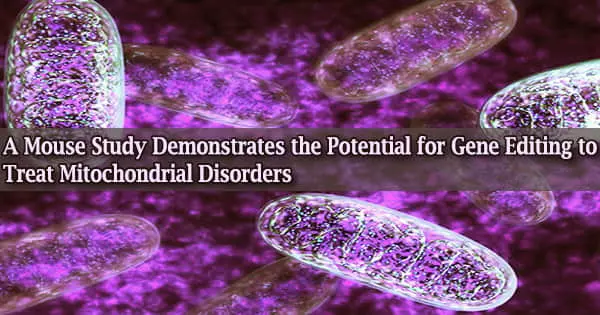Defective mitochondria, the “batteries” that power our bodies’ cells, could be restored in the future via gene-editing techniques. Scientists at the University of Cambridge have demonstrated that they can alter the mitochondrial DNA in live mice, paving the possibility for new treatments for mitochondrial diseases that are currently incurable.
Mitochondria are the powerhouses of our cells, providing them with the energy they need to function. A small bit of mitochondrial DNA codes for each of these mitochondria. Mitochondrial DNA accounts for only 0.1 percent of the human genome and is only passed down from mother to child.
Mitochondrial diseases are chronic, hereditary, and often inherited conditions in which mitochondria fail to provide enough energy for the body to function normally. A hereditary mitochondrial illness affects one out of every 5,000 people.
Mitochondrial DNA flaws can impact how well the mitochondria function, leading to mitochondrial disorders, which are serious and frequently deadly diseases that affect about 1 in 5,000 people. The illnesses are incurable and, for the most part, untreatable.
Each cell contains approximately 1,000 copies of mitochondrial DNA, and the fraction of these that are damaged or altered determines whether or not a person will develop mitochondrial disease.
Mitochondrial diseases can impact cells in the brain, nerves, muscles, kidneys, heart, liver, eyes, ears, and pancreas, among other organs. Mitochondrial dysfunction occurs when the mitochondria fail to operate properly as a result of another disease or condition.
There’s clearly a long way to go before our work could lead to a treatment for mitochondrial diseases. But it shows that there is the potential for a future treatment that removes the complexity of mitochondrial replacement therapy and would allow for defective mitochondria to be repaired in children and adults.
Dr. Michal Minczuk
For a disease to manifest, more than 60% of the mitochondria in a cell must be defective, and the more defective mitochondria a person has, the more serious their sickness will be. The disease could be addressed if the fraction of faulty DNA could be lowered.
“Heteroplasmic” refers to a cell that has both healthy and defective mitochondrial DNA. A cell is homoplasmic if it lacks healthy mitochondrial DNA.
In 2018, researchers from the University of Cambridge’s MRC Mitochondrial Biology Unit used an experimental gene therapy treatment on mice and were able to successfully target and destroy defective mitochondria DNA in heteroplasmic cells, allowing healthy mitochondria to take their place.
“Our earlier approach was very promising and was the first time that anyone had been able to alter mitochondrial DNA in a live animal,” explained Dr. Michal Minczuk.
“But it would only work in cells with enough healthy mitochondrial DNA to copy themselves and replace the faulty ones that had been removed. It would not work in cells whose entire mitochondria had faulty DNA.”
Dr. Minczuk and colleagues employed a biological tool known as a mitochondrial base editor to change the mitochondrial DNA of living mice in their newest advance, which was reported today in Nature Communications.
A modified virus is used to transport the medication into the mouse’s bloodstream, where it is subsequently taken up by its cells. The tool searches for a certain sequence of base pair pairings among the A, C, G, and T molecules that make up DNA.
It then switches the DNA base, in this case from C to T. In theory, this would allow the tool to repair specific “spelling mistakes” that cause mitochondrial dysfunction.
Because there are no adequate animal models of mitochondrial DNA disorders at this time, the researchers tested the mitochondrial base editors on healthy mice. It does, however, reveal that editing mitochondrial DNA genes in a live animal is doable.
Pedro Silva-Pinheiro, a postdoctoral researcher in Dr. Minczuk’s lab and first author of the study, said: “This is the first time that anyone has been able to change DNA base pairs in mitochondria in a live animal. It shows that, in principle, we can go in and correct spelling mistakes in defective mitochondrial DNA, producing healthy mitochondria that allow the cells to function properly.”
Mitochondrial replacement therapy, often known as ‘three-person IVF,’ is a technique developed in the United Kingdom that allows a mother’s faulty mitochondria to be replaced with those from a healthy donor.
However, this approach is difficult, and even regular IVF only works in one out of every three rounds.
Dr. Minczuk added: “There’s clearly a long way to go before our work could lead to a treatment for mitochondrial diseases. But it shows that there is the potential for a future treatment that removes the complexity of mitochondrial replacement therapy and would allow for defective mitochondria to be repaired in children and adults.”
The research was funded by the Medical Research Council UK, the Champ Foundation and the Lily Foundation.
















